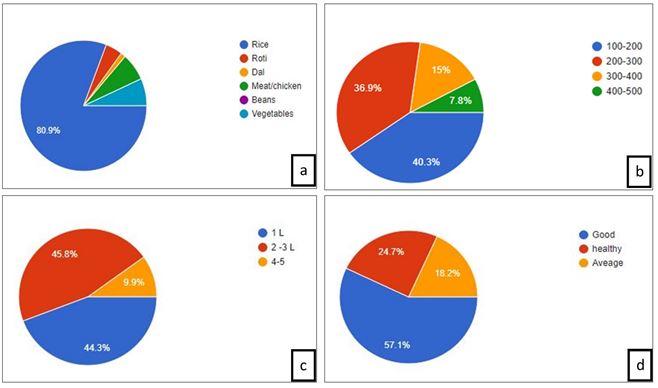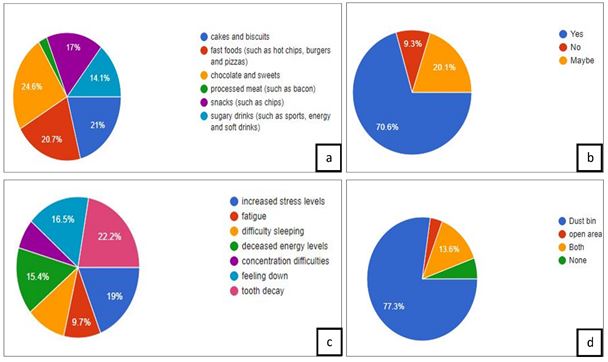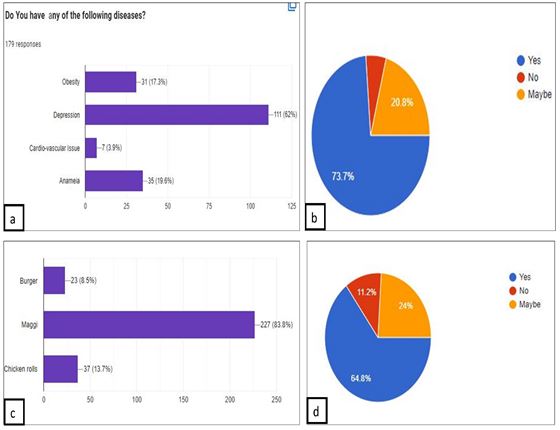 |
| Figure 1: a) Staple Food b) Quantity of staple food c) Amount of water d) Overall health |
 |
| Figure 1: a) Staple Food b) Quantity of staple food c) Amount of water d) Overall health |
 |
| Figure 2: a) Junk food consumption b) Emotional health and Junk food c) Junk food and diseases d) Disposal of wrappers |
 |
| Figure 3: a) Status of diseases b) Wrappers and threat to the environment c) Specific Fast foods d) Prefer to pay extra for products wrapped in biodegradable material |
Author |
Study Area |
Sample Size |
Major Findings |
Recommendations |
Gupta et al |
India |
|
Due to the economic boom and the entry of numerous foreign players in the food industry, Indian citizens have been exposed to an abundance of ultra-processed, high-sugar, high-salt, and high-fat foods, which has led to a rise in the prevalence of diseases like diabetes and hypertension that are related to being overweight and obese. According to Gupta et al., India is dealing with a pandemic of excessive and incorrect nutrition. |
Due to the rise in illnesses that can be prevented by changing one's diet, it is necessary to implement preventive strategies at the national level and test their effectiveness in lowering consumption of junk food and the resulting health problems. Citizens must be made aware of the serious dangers these foods pose, and political will must be sufficiently strong to produce legislation and national-level policies that support different nutritional needs. |
Harris et al |
|
|
Adolescents may be even more susceptible than younger kids to the allures of junk food marketing, and this exposure has a negative influence on the dietary habits, food preferences, and long-term health of adolescents. Junk food businesses see young people as prospective, devoted clients for life, so marketing to attract young consumers to their products is a highly profitable investment. A major commercial risk is the potential regulation of food marketing to teenagers. |
Additional scholarly research on how food marketing specifically impacts teenagers and the effectiveness of proposed safeguards to keep them safe is essential to support stricter regulations on junk food corporations that mislead consumers about public health risks. There is a need for more research to better understand how social media and other teen-targeted marketing techniques affect adolescents' particular vulnerability, how food advertising activates reward networks in teenagers' brains, and how junk food marketing disproportionately appeals to young people of colour and worsens health disparities in their communities. |
Tempels et al. |
|
|
Businesses must respect people's autonomy, uphold the principle of non-maleficence in both market and nonmarket environments, consider the manipulativeness of their marketing techniques, the degree to which consumers can recognise potential manipulation, the potential negative impact (over)consumption of their product will have on public health, and make people aware of all these fundamental conditions. The food and beverage sector should reconsider promoting harmful items to adults as well as refraining from marketing unhealthy foods to youngsters. |
We can only fully understand what corporate responsibility for public health can entail by evaluating actual practises in the industry, examining perceptions of corporate responsibility within food firms, and considering various food practises in various countries and cultures in the context of rising obesogenic societies. |
Crimarco et al. |
|
|
Ultra-processed food consumption is consistently linked to an increased risk of weight gain in both adults and children, as well as an increased risk of adiposity-related co-morbidities in adults, in studies that are mostly observational. There has been a noted ecological pattern showing that obesity incidence is generally higher in nations with higher UPF consumption. However, not all nations are experiencing this trend, and variations may be explained by |
Although more mechanistic studies are required, because UPFs tend to be more energy-dense than nutrient-dense, cautionary advice to limit UPF consumption is unlikely to result in any additional risk or harm and is more likely to result in a nutritional benefit. |
Wade Jeannette M. |
White and African American Emerging Adults |
1058 |
Respondents who identified as African American would eat more fast food than respondents who identified as White. Respondents who identified as White Americans reported eating less fast food than respondents who identified as men. Numerous cultural and institutional factors encourage African Americans to eat fast food. People who rate highly on the femininity scale eat less fast food than people who rate highly on the masculinity scale. For White American emerging adults, education reduces the frequency of eating fast food, not employment. |
Instead of using societally imposed ideas of masculinity and femininity, social scientists should investigate how African Americans define these concepts for themselves. |
Li Yanxia et al. |
China |
228 |
It has been discovered that perceived threats, such as the perceived seriousness of using a product, the perceived susceptibility of the product, and the dread of using a anti-junk food practises. The association between the consumption of junk food and obesity has also been found to be significantly moderated by the awareness of product knowledge concealing. |
The general public should be made aware of the product's ingredients as well as any warnings regarding unfavourable effects of using or consuming junk food. It is crucial to teach children how to read the information on product packaging and how it might help them to comprehend the risks involved. |
Renzo Laura Di et al |
Italy |
3533 |
Consuming seasonal foods and foods high in antioxidants is highly protective against the development of chronic diseases that cannot be transmitted because they reduce inflammation and oxidative damage, which are dependent on the consumption of junk and ultra-processed food in the postprandial period. |
Future, more in-depth population studies must verify and examine the data. It is strongly advised to cut back on junk food consumption to lessen the "obesogenic milieu" that contributes |
Boylan et al |
Australia |
14509 |
A poorer diet and a higher body mass index have been linked to watching TV while eating dinner. High scores on the junk food intake measure were linked to unhealthy parenting and family environments. Parents frequently reward their children's good behaviour with sweet snacks, despite the fact that there is evidence linking overeating and increased consumption of unhealthy foods to long-term health consequences. |
As long as junk food intake among Australian youngsters is an issue, public health professionals must keep working to reduce its usage. The public health workforce must keep implementing effective initiatives to address unhealthy eating habits and the risk of being overweight or obese. As analysing consumption of individual foods may not give a whole picture of dietary health, it is necessary to look at food clustering. |
S Ankul Singh et al |
India |
|
Obesity damages organs and, like other malnutrition-related conditions, is known to reduce leucocyte count and cell-mediated immune responses. But not only has substantial psychological effects that can harm a child's intelligence and personality, it also causes physiological repressions. Children and teenagers are more prone to gaining weight, losing immunity, and becoming infectious during the third wave of COVID-19 when junk food, physical inactivity, and ongoing psychological stressors are combined. |
Children and young adults must be made urgently aware of these negative effects of junk food and the fact that they should not be used as a substitute for a healthy diet. There has never been a better time than the present to create a nurturing environment that promotes the inclusion of children and young people in society and good health. |
Azemati B et al. |
Iran |
14,400 |
According to Azemati B et al., people who ate junk food were more likely to be overweight or carry extra weight. In terms of metabolic factors, "overweight" and "high blood pressure" stood out the most. High systolic and diastolic blood pressure was more prevalent in junk food eaters. With regard to cardio-metabolic risk factors, Iranian children and adolescents who consumed junk food experienced negative effects. Urban residence and a higher BMI were associated with metabolic syndrome (P=0.004), as well as being more prevalent. |
One way to encourage teenagers to choose healthy foods and reduce overweight and obesity is by improving their nutritional understanding. Limiting the intake of sugar-sweetened beverages, salty and fatty snacks, and other foods with added sugar can help children and young adults' cardiovascular health. |
LalanzaJaume F et al |
|
|
The consequences of a CAF diet on behaviour include increased snacking, decreased hedonic value of other rewards like sucrose and ethanol, impairment of spatial and contextual memory, and a propensity for anxiolytic and antidepressant effects, mostly in animals who have already experienced stress. |
To account for methodological discrepancies, more study is required, which should result in findings that are more consistent. Basic animal studies are required to understanding not only the physiological and behavioural impacts of junk food, but also the causes and risk factors for overeating these sorts of food items. |
Wahl et al. |
Helsinki Finland |
38 |
Consumption of vegetables was the major factor in eating happiness, which was calculated over an eight-day period. On average, eating sugary foods made people feel equally happy as eating "healthy" foods like fruits or vegetables. Dinner produced similar eating pleasure to snacking. We might learn more about the experience of eating happy if we broaden the definition of "nutrition" to include the amount, timing, location, duration, and company of eating. |
More thorough and sensitive measurements of the behaviour are required to have a deeper knowledge of how eating behaviours are controlled. Mobile technology advancements offer considerable hope for practical dietary evaluation based on image-assisted techniques. |
Lee et al. |
U.S |
1524 |
When compared to fruit intake, fast food consumption was associated with higher levels of depression in young women. People with lower incomes and those without jobs are more likely to eat fast food, which increases their chance of developing depression. The impact of fruit consumption on depression was larger in unemployed women than in employed women, who have easier access to fruits. |
While we investigate how much fast food, soda, fruit, and vegetables are consumed, other foods may have an impact on young women's depression. Young women should be the focus of nutrition programmes designed to persuade them to consume fewer unhealthy foods, such as fast food, and more nutritious ones, such as fruit. These programmes could offer coupons for local farmer's markets or other financial aid to help young women afford healthier foods, or they could offer free cooking classes in the neighbourhood to teach easy recipes to combat the convenience of fast food. |
Khongrangjem T et al |
Karnataka, India |
160 |
A balanced diet with adequate nutrition is essential for human growth and development. The majority of students, particularly kids and young adults, eat fast food around mealtime and become accustomed to its flavour. Despite being pleasant, fast food has excessive calories and poor nutritional value. Nutritional counselling on the value of a balanced diet and the negative impacts of fast meals may aid in reducing the addiction to fast food. |
To ensure that students are aware of the negative effects of fast food and the benefits of a balanced diet, a study must be conducted in conjunction with an awareness campaign about them. |
Socio demographic Characteristics |
Average |
Gender |
M = 103 F= 260 |
Average Age |
21 Years |
Religion |
Islam |
Place of Residence |
Rural |
Average Height |
5’4’’ Feet |
Average weight |
57.02 Kg |
Average Monthly Income of family |
20000/ |
Environmental Parameter |
Percentage |
|
Where you put wrappers |
Dust bin = 77.4 % open area = 3.5% Both = 13.5% None = 5.5% |
p< 0.0912 |
Do you think wrappers are hazardous to Environment |
Yes = 73.8% No = 5.5 % May Be =20.7 % |
p< 0.4040 |
Do you agree that recycled biodegradable materials are good for environment |
Strongly disagree =8.8% Disagree =5.9% Neutral =- 8.8% Agree = 41.2% Strongly agree = 35.3 |
p< 0.0005 |
Will you buy products with biodegradable packing |
Yes = 64.9% No = 23.9% May Be =11.1% |
p< 0.2192 |
Will you extra for product wrapped in biodegradable material |
Yes = 41.7% No = 26.4% May Be =31.9% |
p< 0.0023 |
Fast food and factors |
Value/Percentage |
P value |
Staple food |
Rice |
|
Average consumption |
250-350 |
|
Major fruits consumed (Quantity) |
Apples (100-150 gm) |
|
Average No of eggs consumed per day |
1 = 15.6% 2 = 19.9% 4 = 19.3% >5 = 35.6% |
p< 0.0001 |
Water consumption per day |
1 ltr = 44.4% 2 -3 ltr = 45.7% 4-5 ltr = 9.9% |
p< 0.1147 |
Present Health Status |
Average = 18.2% Good = 57.2% Healthy =24.6% |
p< 0.1227 |
Do you have any of the disease |
Obesity= 17.8% Depression=61.7% Cardio-vascular =3.9% Anemia = 19.4 |
p< 0.0333 |
Fast food consumption |
Cakes & Biscuits = 21.2% Hot Chips, Burger, Pizza = 20.6% Chocolate & Sweets = 24.5 Processed meat = 2.6% Snacks = 17% Sugar drinks = 14.1 |
p< 0.0001 |
Do you take any of them |
Burger = 8.6% Maggi = 83.8% Chicken Rolls = 13.6 % |
p< 0.4410 |
Average expenses |
Rs 49/= |
|
health conditions/ symptoms after eating these foods |
Increased Stress Levels = 19.3% Fatigue = 10.4% Difficulty Sleeping = 9.6% Deceased Energy Levels = 15.4% Concentration Difficulties =6.8% Feeling Down =16.4% Tooth Decay = 22.1% |
p< 0.0001 |